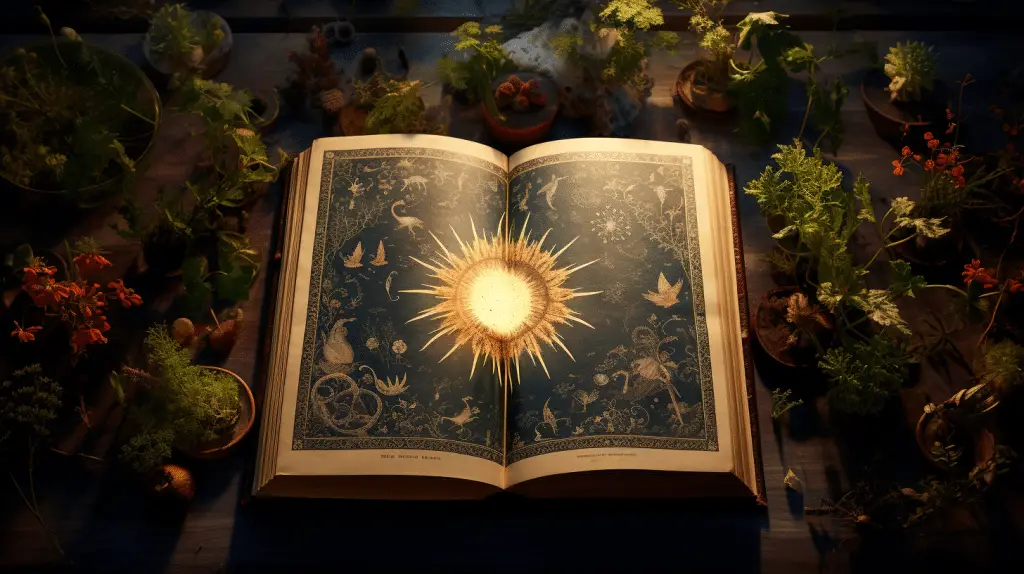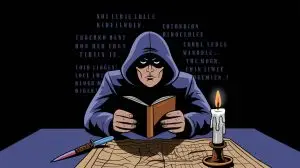The Voynich Manuscript is a mysterious book that has puzzled scholars and experts for over a century. It is an illustrated codex, written in an unknown script by an unknown author. The manuscript has no clear purpose, and its contents have remained a mystery since it was rediscovered in 1912 by rare books dealer Wilfrid Voynich.

Despite numerous attempts to decipher the script and identify the book’s purpose, the Voynich Manuscript remains an enigma. The text is written in a language that has yet to be identified, and the illustrations are equally baffling. Some of the images depict plants and animals that do not exist, while others show women bathing in what appear to be pools of green liquid. The book’s origins are also shrouded in mystery, with little known about its early history.
Historical Background

The Voynich Manuscript is a mysterious book that has puzzled scholars and experts for centuries. The manuscript is hand-written in an unknown script referred to as ‘Voynichese’ and is illustrated with intricate drawings of plants, animals, and celestial bodies. Carbon dating has shown that the vellum on which it is written dates back to the early 15th century (1404-1438).
The manuscript’s history is shrouded in mystery. It is named after Wilfrid Voynich, a Polish nationalist and antiquarian book dealer who acquired the manuscript in 1912. Voynich claimed that the manuscript had been owned by Emperor Rudolf II and that it had been written by the English philosopher and friar Roger Bacon in the 13th century. However, there is no evidence to support these claims.
Over the years, the manuscript has been attributed to various authors, including the Society of Jesus, John Dee, Johannes Marcus Marci, Jacobus Horcicky de Tepenecz, and Athanasisus Kircher. Some have even suggested that it was written by aliens. However, none of these claims have been substantiated.
The manuscript is currently housed at the Beinecke Rare Book and Manuscript Library at Yale University. It has been studied extensively by scholars and cryptographers, but to this day, no one has been able to decipher its contents. In recent years, the manuscript has been the subject of renewed interest, with new theories and interpretations emerging. However, the mystery of the Voynich Manuscript remains unsolved.
Manuscript Description

The Voynich Manuscript is a mysterious book consisting of 240 pages. It is a codex, meaning it is a book made up of pages bound together, as opposed to a scroll. The manuscript is written on vellum, which is a type of parchment made from animal skin.
One of the most intriguing aspects of the Voynich Manuscript is the script in which it is written. The script is completely unknown, and has yet to be deciphered. It consists of a series of characters that have no known meaning or relation to any known language or alphabet.
Despite the mysterious script, the manuscript contains many illustrations that have been the subject of much study and speculation. The illustrations include botanical drawings of 113 unidentified plant species, as well as astronomical and astrological drawings, including astral charts with radiating circles, suns and moons, and Zodiac symbols.
The Voynich Manuscript is a unique and enigmatic work that continues to fascinate scholars and researchers. Its origins, purpose, and meaning remain a mystery, and it continues to be a subject of much debate and speculation in the academic community.
Content Analysis

The Voynich Manuscript is a mysterious book that has puzzled scholars for centuries. The text is written in an unknown language and is accompanied by intricate illustrations of plants, astronomical and astrological symbols, and naked women bathing. The manuscript is believed to have been written in the early 15th century, and its author and purpose remain unknown.
The manuscript is divided into several sections, including herbal, pharmaceutical, and balneological drawings. The herbal section contains detailed illustrations of 113 unidentified plant species, while the pharmaceutical section contains drawings of various medicinal herbs. The balneological section contains drawings of interconnecting tubes and naked females bathing.
The manuscript also contains astronomical and astrological drawings, including astral charts with radiating circles, suns and moons, and Zodiac symbols such as Pisces and Scorpio. The cosmological section contains cosmological medallions and geographical forms.
The Voynich Manuscript is written in a cipher, and attempts to decode the text have been unsuccessful. Some scholars believe that the text is written in a form of medieval Latin, while others believe that it is written in an unknown language. The manuscript also contains gibberish and Hebrew letters, adding to its mysterious nature.
In addition to its pharmaceutical and herbal drawings, the manuscript also contains alchemical and magical symbols and drawings of planets. The manuscript’s purpose and intended audience remain unknown, and its content continues to baffle scholars and researchers.
Ownership and Provenance

The Voynich Manuscript has a fascinating ownership and provenance history. The book is named after Wilfrid Voynich, a Polish book dealer who purchased the manuscript in 1912. However, the book’s origins are shrouded in mystery.
The manuscript is believed to have been produced in Central Europe during the 15th century. It is thought to have been owned by Holy Roman Emperor Rudolph II in the late 16th and early 17th centuries. After Rudolph’s death, the book’s ownership is unclear until the early 17th century when it was owned by Jacobus Horcicky de Tepenecz, a Czech alchemist.
In the early 18th century, the book was acquired by the Jesuit College at Frascati, Italy. The book was later sold during a secret sale of books in 1903 by the Society of Jesus in Rome. It was during this sale that Wilfrid Voynich acquired the manuscript.
The book is currently housed in the Beinecke Rare Book and Manuscript Library at Yale University. The book’s ownership and provenance history have been the subject of much speculation and research over the years. However, the book’s true origins and purpose remain a mystery.
Attempts at Decipherment

For over a century, scholars have attempted to decipher the mysterious Voynich Manuscript, a book written in an unknown script with illustrations of plants, animals, and astronomical diagrams. Despite numerous attempts, the manuscript’s unique text, made up of a mixture of handwritten Latin letters, Arabic numbers, and unknown characters, has so far resisted all attempts at translation.
One of the most recent attempts at deciphering the manuscript was made by Nicholas Gibbs, a British researcher and television writer. In 2017, Gibbs claimed to have deciphered some of the text using a cryptographic algorithm. However, his claims were met with skepticism by other scholars, who argued that Gibbs had not provided enough evidence to support his findings.
Another attempt at decipherment was made by Dr. Gerard Cheshire, a researcher at the University of Bristol, who claimed to have decoded the manuscript in 2019. Cheshire argued that the manuscript was written in a constructed language, similar to Esperanto, and that it was a pharmacopoeia, or a book of medicinal recipes. However, his claims have also been met with skepticism by other scholars, who have criticized his methodology and argued that his findings are not supported by the available evidence.
Despite these attempts at decipherment, the Voynich Manuscript remains one of the most enigmatic books in history, and its true meaning and purpose continue to elude scholars and researchers.
Controversies and Theories

The Voynich Manuscript has been the subject of much controversy and speculation since its discovery. Many theories have been put forward over the years to explain the meaning and purpose of the book, but none have been proven definitively.
One theory is that the book is a hoax, created by an unknown person or group as a way to deceive or entertain others. This theory is supported by the fact that the book contains many strange and nonsensical images and symbols, as well as a language that has never been deciphered.
Another theory is that the book is a religious text, possibly related to a heretical Christian sect. This theory is based on the fact that the book contains many images of plants and astrological symbols, which some have interpreted as having religious significance.
Some researchers have suggested that the book may have been created as a form of cryptography, with its strange symbols and language serving as a code that only a select few could understand. This theory is supported by the fact that the book contains many repetitions of certain symbols and patterns, which could be seen as a form of encryption.
Despite the many theories that have been put forward over the years, the true meaning and purpose of the Voynich Manuscript remains a mystery. Researchers continue to study the book in the hopes of unlocking its secrets, but so far their efforts have been unsuccessful.
In recent years, the manuscript has been carbon dated to the mid-fifteenth century and it is thought to have been composed in Northern Italy during the Italian Renaissance. The book was purchased by a Polish book dealer named Wilfred M. Voynich in 1912 and has been a source of fascination for scholars ever since.
Lisa Fagin Davis, the executive director of the Medieval Academy of America, has called the Voynich Manuscript “the most mysterious manuscript in the world.” Despite the efforts of cryptologists, computational linguists, and other experts, the book remains unreadable.
In 2017, a team of researchers claimed to have cracked the code of the manuscript using artificial intelligence and machine learning. However, their findings have been met with skepticism by many experts in the field.
Theories and controversies surrounding the Voynich Manuscript are likely to continue for many years to come, as researchers and enthusiasts alike continue to study this enigmatic and mysterious book.
Steve is the creative force behind My Unique Tales, a blog dedicated to sharing captivating stories that explore the human experience in all its complexity. With a passion for writing and a talent for crafting engaging narratives, Steve's blog is a treasure trove of imaginative tales that transport readers to other worlds and challenge them to see things from new perspectives. From epic adventures to intimate character studies, Steve's stories are always thought-provoking and emotionally resonant. With a growing following of readers who appreciate his unique voice and creative vision, Steve is quickly becoming a rising star in the world of online storytelling.






